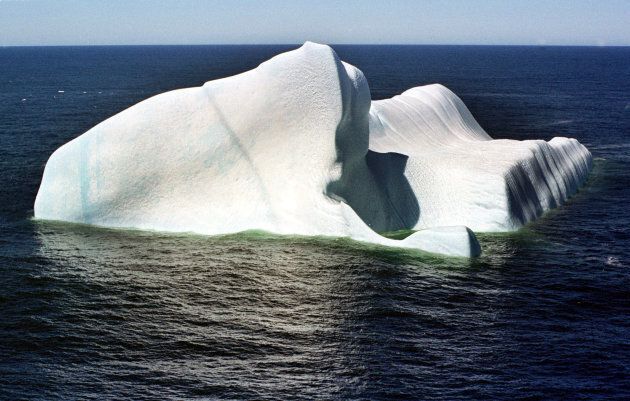If you thought the plan to save the Great Barrier Reef by pumping cold water into it was absurd, you will have a hard time believing this.
A United Arab Emirates company wants to tow a giant iceberg over 9,000km from Antarctica to the Arabian peninsula and then break it down to use as drinking water.
The UAE is one of the most water scarce countries on the planet -- it receives an average rainfall of just 94.3mm each year, and its groundwater is predicted to dry up within the next 15 years.
But it seems its residents haven't really taken the need for conservation on board; the UAE has the highest water consumption per capita in the world, according to a report by the Emirates Industrial Bank.
Around 70 percent of the world's fresh water is locked up in Antarctica's ice sheets.
Still, as desperate and wild schemes to deal with our changing climate and growing populations go, this is definitely up there.

We'll get to whether or not such a plan is even possible in a moment, but first, what exactly is the company planning to do?
Abu Dhabi-based environmental consultancy National Adviser Bureau announced the project earlier this month, which they say will commence at the beginning of next year.
The plan is to use powerful tow boats to drag a 3km-long iceberg an estimated 9,200km across the Indian Ocean, anchor it 24 kilmoetres off the coast of the UAE and chip away at it for drinking water.
If successful, the National Advisor Bureau plans to continue the scheme with more icebergs to supply the water-scarce UAE with clean drinking water.
An iceberg of this size contains around 75 billion litres of water, according to company director Abdullah Mohammad Sulaiman Al Shehi -- that's 30,000 Olympic swimming pools.
Al Shehi says this could provide drinking water for one million people over five years.
"This is the purest water in the world," Al Shehi told Golf News.
"We have formulated the technical and financial plan. Towing is the best method. We will start the project in beginning of 2018."
He told Gulf News the company has mapped out the route. They estimate it will take one year to tow the iceberg to the Fujairah, the UAE's most northern emirate, during which time 30 per cent of it will have melted.
You can watch the promotional video for the project here:
The National Advisor Bureau refused to be drawn on costings for the ambitious project, saying it was a matter of proprietary.
What's more, they're actually billing the move as an environmental measure, suggesting it as an alternative to energy-intensive desalination of ocean water, which currently provides most of the UAE's drinking water.
While it seems like towing an enormous lump of frozen water half way across the world might also burn a fair bit of fuel, we thought we'd thought ask an expert.
Professor Grant Bigg is a professor in earth science systems, and a specialist in all things icebergs.
He said that not only would it be extremely expensive -- it could have serious implications for marine life.
"Without doing the sums, I would have thought taking an iceberg from the Southern Ocean to Arabia would be pretty resource intensive," he told HuffPost Australia.
"Think of the energy used in the towing process, the manufacture of sleeves and cables to insulate and tow the iceberg, and protecting it once offshore."
They also haven't addressed the small matter of the iceberg's survival in the scorching climate of the UAE -- the water off the coast of Fujairah averages a balmy 30 degrees.
"The meltwater may also have an impact on the local ecology, both through freshening the water and making it colder, and the local ecosystem will of course be used to very different conditions," Professor Bigg explained.
It could also cause serious damage to the sea floor if it was grounded -- even creating a small tsunami.
"And grounding would constantly evolve - every time ice was removed the iceberg would need to be moved into shallower water to be grounded, likely creating a scar on the sea floor," Bigg said.
"Alternatively, if harvesting was not done carefully the iceberg might be destabilised by the ice removal and rollover, creating a local mini-tsunami."
Although it's hard to have confidence in a company that thinks polar bears live in Antarctica and hang out with penguins, the idea is actually not new.
In fact, it's been floated at various times for the past two centuries.
French engineer Georges Mougin, who reportedly acted as an adviser on this latest project, was employed by the Saudi royals to look into the idea in the 1970s.

That scheme involved locating a 100 million-tonne iceberg off the coast of Antarctica, wrapping it in sailcloth and plastic to slow its melting and tugging it to the coast of the Arabian peninsula.
At the time, the trip was estimated to take around eight months and cost about $100 million.
Even NASA weighed in on the idea, proposing that the icebergs be tracked by spacecraft.
You can read about other iceberg towing schemes here -- including a successful project in the 1960s developed by oil companies to tug icebergs away from their rigs in the Labrador Sea. Iceberg towing for this purpose continues today, although of course, the icebergs are far smaller in scale (the largest is believed to be 4 million tonnes) and were only dragged a few kilometres through icy cold water.
Professor Bigg told HuffPost Australia that taking an iceberg all the way to the UAE would be a very different story.
Even much larger icebergs which float out of the Weddell Sea generally broke up before they got past the latitude of South Africa, lasting only around six months, Bigg said.
"For an iceberg a tenth of this size to survive a journey across the equator would require extensive insulation and a significant towing speed (which will enhance melting), both of which would be very expensive.
"As the iceberg got smaller the chance of breakup or rollover is likely to increase, adding major complications, and hazards, to the towing."
But it looks like the ambitious plan could be doomed to failure before its had the chance to prove just how crazy it really is.
The UAE's Minstry of Energy have poured cold water on the idea, refuting reports that plans to "import" an iceberg were underway.
In an official statement released this week, the Ministry said: "As the authority in charge of water affairs, (the Ministry of Energy) would like to confirm that such news is just a rumour."
So it looks like we'll have to put this project on ice until the next dreamer comes along.
ALSO ON HUFFPOST AUSTRALIA